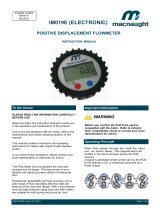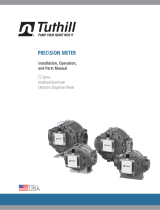Page is loading ...

IM217P-MC Issue 5 © 2020 Page 1 of 8
INSTRUCTION MANUAL
To the Owner
POSITIVE DISPLACEMENT
FLOWMETER - IM019P (PULSE)
PLEASE READ THIS INFORMATION CAREFULLY
BEFORE USE.
Read and retain this instruction manual to assist you
in the operation and maintenance of this product.
If you have any problems with the meter, refer to the
maintenance and trouble shooting sections of this
manual.
This manual contains connection and operating
instructions for meters with Pulse outputs.
If you need further assistance, please contact your
local representative or distributor for advice.
This Flow Meter has incorporated the oval rotor
principal into its design. This has proven to be a
reliable and highly accurate method of measuring
flow.
Exceptional repeatability and high accuracy over a
wide range of fluid viscosities and flow rates are
features of the oval rotor design. With a low pressure
drop and high pressure rating oval rotor flow meters
are suitable for both gravity and pump (in line)
applications.
INCLUDES MODELS
IM217P-01
IM217P-02

IM217P-MC Issue 5 © 2020 Page 2 of 8
Important Information
Operating Principle
WARNING
Before use, confirm the fluid to be used is
compatible with the meter. Refer to Industry
fluid compatibility charts or consult your local
representative for advice.
When fluid passes through the meter the rotors
turn, as shown below. The magnets which are
located in the rotors will pass across the PCB
sensors.
A signal is generated which is then sent by the PCB
to the relevant LCD, or receiving instrument as a
Pulse Output.
Maintenance Procedures.
Disassembly
Ensure that the fluid supply to the meter is
disconnected, and the line pressure is released
before disassembly, with the exception for repair or
maintenance to the PCB where it is not necessity to
isolate the meter from flow. Refer to the exploded
parts diagram on subsequent pages for item
numbers.
1. Unscrew the four retaining screws (item 2) and
remove the Electronic Module (item 3)
2. Check for evidence of moisture into the electronic
housing. If there is evidence of this check the
condition of the O-Ring (item 4)
3. To access the Rotor assembly, remove the 8
Meter Cap screws (item 9)
4. Remove the rotors (item 6) and inspect the
condition of each.
Also investigate if there is the presence of any
foreign material in the meter body, that may inhibit
the rotors performance
Reassembly
Note:
1.The rotors must be fitted with rotor magnets
facing up towards the electronic module
(i.e. The magnets being in close proximity to the
Electronic module).
When replacing the rotors the top face of the
rotors should be flush with the sealing face of the
meter body.
2. Replace the rotors (Item 6) onto the shafts at 90
degrees to each other (as per diagram on the left)
and check their operation by turning either of the
rotors.
If the rotors are not ‘in mesh’ correctly or do not
move freely, remove one of the rotors and replace
correctly at 90 degrees to the other rotor.
3. Check the Rotors (item 6) rotate freely.
4. Replace the 0-Ring (item 7) into the groove of the
Meter Cap (item 8).
5. Replace the Meter Cap onto Meter Body (item 5)
Tighten Meter Cap screws (item 9) in a diagonal
sequence to 7 Nm
E.g. 1, 5, 3, 7, 4, 8, 6, 2
6. Replace the O-Ring (item 4) into the Electronic
Module (item 3) and mount the Electronic module
onto to the Meter Body
7. Replace and tighten the Retaining Screws (item 2)
in diagonal sequence.
8. Before returning to service test the meter by
turning the Rotors with your finger. Or applying a
very low air pressure (no more than a good
breath) to the meter
INSTALLATION
1. Ensure fluid used is compatible with the meter.
2. It is strongly recommended that a strainer is
installed before the meter for every application.
Meters damaged by particles in the fluid may not
be covered by warranty.
3. To prevent meter damage from entrapped air,
during intitial commissioning or after maintenance,
slowly refill slowly pipe system with fluid before
starting the pumping system.
4. Use a liquid thread sealant on all pipe fittings.
5. Use flexible pipe connections to prevent meter
strain.
6. Ensure the meter is mounted with the shafts in
the horizontal plane.
7. Fit a system pressure relief valve to prevent meter
damage due to thermal expansion.
8. Refer to specifications for sensor electrical details.

IM217P-MC Issue 5 © 2020 Page 3 of 8
Product Specifications
Troubleshooting Guide
Problem Cause Remedy
Fluid will not flow
through meter
a) Foreign matter blocking rotors
b) Damaged rotors
c) Meter connections over tightened
d) Fluid is too viscous
a) Dismantle meter, clean rotors
b) Replacement rotor assembly required.
c) Re-adjust connections
d) See specifications for maximum viscosity
Reduced flow
through meter
a) Partially blocked
b) Fluid is too viscous
a) Check and clean meter.
b) See specifications for maximum viscosity
Meter reading
inaccurate
a) Fluid flow rate is too high or too low
b) Air in fluid.
c) Excess wear.
a) See specifications for minimum and maximum flow rates
b) Bleed air from system
c) Check meter body and rotors. (see instructions)
Meter not giving a
pulse signal
a) Faulty reed switch
b) Magnets failed
a Replace PCB Board
b Replacement rotor assembly required
Yellow
Green
Reed Switch
Please Note: Not dependant on Polarity
* When tested with lubrication oil 100 @ 25°C. Allowances should be made for changes to these parameters.
Accuracy+/‐0.5%ofreading
TypeOvalGear
Flowrate3‐80L/m(0.8‐21.1USGal/m)
MaximumPressure10342kPa/1500psi/103Bar
MaximumViscocity1000cP(Centipoise)
MaximumTemperature80DegC/131DegF
MinimumTemperature‐14DegC/6.8DegF
K'Factor54.6pulses/Litre‐206.6835pulses/USG
ReedSwitchspecifications
ConditionsMaxUnits
ContactRatingAnyDCcombinationofV&Anotto
exceedtheirindividualmax's10W
OperatingVoltage 30VDC
OperatingAmpere 0.5A
SwitchingCurrent 0.5A
Sensor‐resistance 280mὨ

IM217P-MC Issue 5 © 2020 Page 4 of 8
Exploded Diagram
Parts Identification
Exploded Diagram
1
2
4
Parts Identification
3
5
6
7
8
9
ItemNo PartDescription WettedParts
1Protectiveboot
2Screws
3ElectronicModule‐Pulseoutput
4 O'ring NitrileButadieneRubber(NBR)
5 Meterbody(assembly) 6061T6Aluminium
6Rotorset Ultem1000
7 O'ring NitrileButadieneRubber(NBR)
8 Metercap 6061T6Aluminium
9Screws

IM217P-MC Issue 5 © 2020 Page 5 of 8
Spare Part Codes
Meter Dimensions (mm)
Component Description
ToorderareplacementElectronic
Modulepleasecontactyour
Macnaughtrepresentative
Electronic Modules
Module Reed Switch
(PKIT-IM019-MC)

IM217P-MC Issue 5 © 2020 Page 6 of 8
Notes

IM217P-MC Issue 5 © 2020 Page 7 of 8
Notes

IM217P-MC Issue 5 © 2020 Page 8 of 8
Note:
This product should be disposed of according to all applicable local
and national government environment regulations and guidelines.
For Warranty Terms and Conditions see macnaught.com.au
For a list of Australian Service Centres see macnaught.com.au
/











